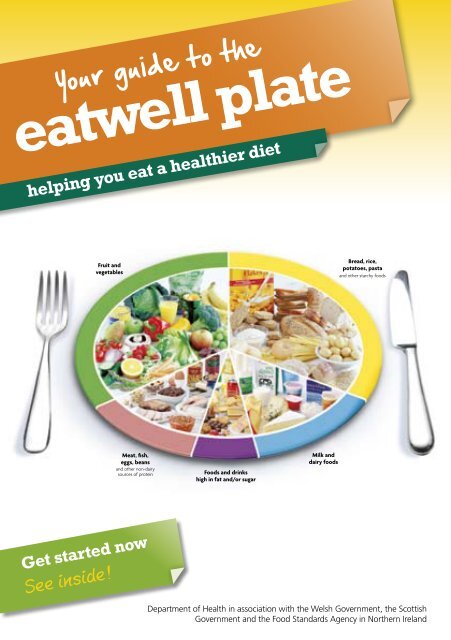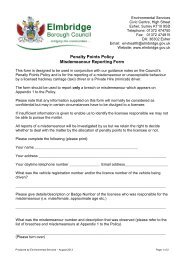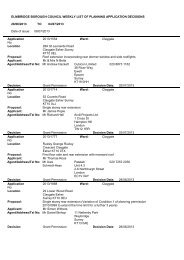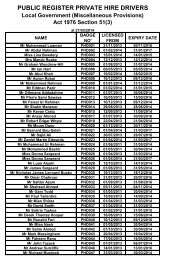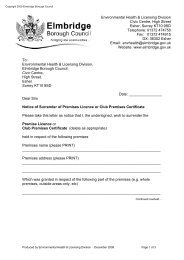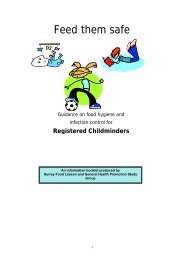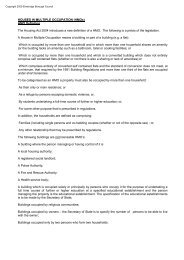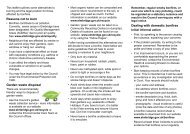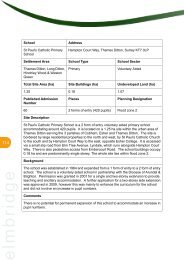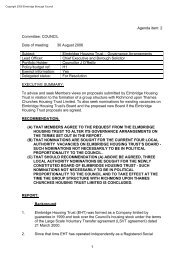The eatwell plate leaflet - Drumchapel LIFE
The eatwell plate leaflet - Drumchapel LIFE
The eatwell plate leaflet - Drumchapel LIFE
You also want an ePaper? Increase the reach of your titles
YUMPU automatically turns print PDFs into web optimized ePapers that Google loves.
<strong>eatwell</strong> <strong>plate</strong><br />
helping you eat a healthier diet<br />
Get started now<br />
See inside!<br />
Department of Health in association with the Welsh Government, the Scottish<br />
Government and the Food Standards Agency in Northern Ireland
Is the <strong>eatwell</strong><br />
<strong>plate</strong> for me?<br />
Eating well and<br />
having a healthy<br />
lifestyle can help us<br />
feel our best – and<br />
make a big<br />
difference to our<br />
long-term health.<br />
So why not get<br />
started today?<br />
<strong>The</strong> <strong>eatwell</strong> <strong>plate</strong> applies to most people,<br />
whether they’re a healthy weight or<br />
overweight, whether they<br />
eat meat or are vegetarian, and it applies to<br />
people of all ethnic origins.<br />
However, it doesn’t apply to children<br />
under two, because they have<br />
different nutritional needs. Between<br />
the ages of two and five, children<br />
should gradually move to eating the<br />
same foods as the rest of the family,<br />
in the proportions shown on the<br />
<strong>eatwell</strong> <strong>plate</strong>.<br />
Anyone with special dietary<br />
requirements or medical needs might<br />
want to check with a registered<br />
dietitian whether the <strong>eatwell</strong> <strong>plate</strong><br />
applies to them.<br />
2<br />
3
<strong>The</strong> <strong>eatwell</strong> <strong>plate</strong><br />
Use the <strong>eatwell</strong> <strong>plate</strong> to help you get the balance right. It shows how<br />
much of what you eat should come from each food group.<br />
Fruit and<br />
vegetables<br />
Bread, rice,<br />
potatoes, pasta<br />
and other starchy<br />
foods<br />
Meat, fish,<br />
eggs, beans<br />
and other non-dairy<br />
sources of protein<br />
Foods and drinks<br />
high in fat and/or sugar<br />
Milk and<br />
dairy foods<br />
4 5<br />
© Crown copyright 2011
How can the <strong>eatwell</strong><br />
<strong>plate</strong> help? How does it work?<br />
Fruit and<br />
vegetables<br />
Bread, rice,<br />
potatoes, pasta<br />
and other starchy<br />
foods<br />
<strong>The</strong> <strong>eatwell</strong> <strong>plate</strong> shows the different types of<br />
food we need to eat – and in what<br />
proportions – to have a well balanced and<br />
healthy diet.<br />
Meat, fish,<br />
eggs, beans<br />
and other non-dairy<br />
sources of protein<br />
Foods and drinks<br />
high in fat and/or sugar<br />
Milk and<br />
dairy foods<br />
So take a look at what you eat<br />
during the day (including any snacks)<br />
and try to eat:<br />
And you might find it easier to get<br />
the balance right over a longer<br />
period, say a week.<br />
As you can see on the <strong>eatwell</strong> <strong>plate</strong>,<br />
the food we eat has been divided up<br />
into five food groups.<br />
the main ingredients and think about<br />
how these fit with the sections on<br />
the <strong>plate</strong>.<br />
plenty of fruit and vegetables<br />
plenty of bread, rice, potatoes,<br />
pasta and other starchy foods –<br />
choose wholegrain varieties when<br />
you can<br />
some milk and dairy foods<br />
some meat, fish, eggs, beans and<br />
other non-dairy sources<br />
of protein<br />
just a small amount of foods and<br />
drinks high in fat and/or sugar<br />
It’s a good idea to try to get this<br />
balance right every day, but you<br />
don’t need to do it at every meal.<br />
When should I use the<br />
<strong>eatwell</strong> <strong>plate</strong>?<br />
You can use the <strong>eatwell</strong> <strong>plate</strong> to help<br />
you make healthier choices whenever<br />
you’re:<br />
at home deciding what to eat,<br />
what to cook or what to shop for<br />
out shopping – aim to fill your<br />
trolley with a healthy balance<br />
of different types of food<br />
eating out in a restaurant, café or<br />
work canteen, or when you’re<br />
choosing food ‘on the run’ – follow<br />
the <strong>eatwell</strong> <strong>plate</strong> to help you<br />
choose a healthy balance<br />
Try to choose a variety of different<br />
food from each of the food groups,<br />
apart from the ‘Foods and drinks<br />
high in fat and/or sugar’ group. This<br />
will help you get the wide range of<br />
nutrients your body needs to stay<br />
healthy and work properly.<br />
It’s important to have some fat in<br />
your diet, but you don’t need to eat<br />
any of the food in the ‘foods and<br />
drinks high in fat and/or sugar’ group<br />
as part of a healthy diet.<br />
Many of the things we eat, such<br />
as pizzas, casseroles, pasta dishes and<br />
sandwiches, are a combination<br />
of the food groups. For these sorts<br />
of food, you just need to work out<br />
For example, if you’re having a<br />
chicken stir-fry with rice, this is made<br />
up of:<br />
chicken – this fits in the section for<br />
meat, fish, eggs, beans and other<br />
non-dairy sources of protein<br />
vegetables – this fits in the section<br />
for fruit and vegetables<br />
rice – this fits in the section for<br />
bread, rice, potatoes, pasta and<br />
other starchy foods<br />
Let’s take a closer look at each of the<br />
food groups...<br />
6 7
A closer look at:<br />
Bread, rice,<br />
potatoes, pasta<br />
and other starchy foods<br />
Starchy food is a really<br />
important part of a healthy<br />
diet and should make up<br />
about a third<br />
of the food we eat. Try<br />
to choose wholegrain<br />
varieties when you can.<br />
Most of us should eat more starchy<br />
food – try to include at least one<br />
starchy food with each of your main<br />
meals. So, you could:<br />
start the day with a wholegrain<br />
breakfast cereal – choose one<br />
lower in salt and sugars<br />
have a sandwich for lunch<br />
round off the day with potatoes,<br />
pasta or rice as a base for your<br />
evening meal<br />
Some people think starchy food is<br />
fattening, but gram for gram it<br />
contains less than half the calories of<br />
fat. You just need to watch the fats<br />
you add when you’re cooking and<br />
serving this sort of food, because<br />
that’s what increases the<br />
calorie content.<br />
Why choose wholegrain?<br />
Wholegrain food contains more fibre<br />
than white or refined starchy food,<br />
and often more of other nutrients.<br />
We also digest wholegrain food<br />
more slowly so<br />
it can help us feel full for longer.<br />
Wholegrain food includes:<br />
wholemeal and wholegrain bread,<br />
pitta and chapatti<br />
wholewheat pasta<br />
brown rice<br />
wholegrain breakfast cereals<br />
and whole oats<br />
8 9
A closer look at:<br />
Fruit and<br />
vegetables<br />
Aim to eat at least five portions of a<br />
variety of fruit and veg each day.<br />
If you count how many portions<br />
you’re having, it might help you<br />
increase the amount and variety<br />
of fruit and veg you eat.<br />
Lots of people know we should be<br />
eating more fruit and veg, but<br />
most of us still aren’t eating<br />
enough. Fruit and veg<br />
should make up about a<br />
third<br />
of the food we eat<br />
each day.<br />
Choose from fresh, frozen, tinned,<br />
dried or juiced.<br />
A portion is 80g or any of these:<br />
1 apple, banana, pear, orange<br />
or other similar-size fruit<br />
3 heaped tablespoons<br />
of vegetables<br />
a dessert bowl of salad<br />
a glass (150ml) of fruit juice<br />
(counts as a maximum of<br />
one portion a day)<br />
10 11
A closer look at:<br />
Milk and<br />
dairy foods<br />
Try to eat some milk and dairy food<br />
– such as cheese, yoghurt and<br />
fromage frais –<br />
every day.<br />
<strong>The</strong>se are good sources of protein<br />
and vitamins, and they’re also an<br />
important source of calcium, which<br />
helps to keep our bones strong.<br />
Some dairy food can be high in fat<br />
and saturated fat, but there are<br />
plenty of lower-fat options to choose<br />
from. For example, why not try 1%<br />
fat milk – it contains about half the<br />
fat of semi-skimmed – or reduced-fat<br />
cheese? Or you could have just a<br />
small amount of the high-fat<br />
varieties less often.<br />
Checking<br />
the label<br />
When you’re food shopping, it’s<br />
a good idea to look at the label<br />
to help you make a healthier choice.<br />
Try comparing similar products and<br />
choose the ones<br />
with less fat, saturated fat, sugars<br />
and salt. Sometimes there can<br />
be a big difference between<br />
similar products.<br />
Many foods are now labelled with<br />
nutrition information. Front of pack<br />
nutrition labels contain information<br />
to help you make decisions, such as<br />
percentage of your Guideline Daily<br />
Amount and/or traffic light colour<br />
coding. Where traffic light colours<br />
are used, you can tell at a glance if<br />
they are high (red), medium (amber)<br />
or low (green) in fat, saturated fat,<br />
sugars and salt.<br />
¼ pie (175g) typically contains (pack serves 4)<br />
Calories<br />
383 kcal<br />
Fat<br />
MEDIUM<br />
18.5g<br />
26%<br />
Saturates<br />
HIGH<br />
8.9g<br />
45%<br />
Sugars<br />
LOW<br />
2.2g<br />
2%<br />
of your guideline daily amount<br />
Salt<br />
MEDIUM<br />
1.28g<br />
21%<br />
For a healthier choice, try to pick<br />
products with more greens and<br />
ambers and fewer reds.<br />
To find out more, see<br />
nhs.uk/foodlabels<br />
12<br />
13
A closer look at:<br />
Meat, fish,<br />
eggs, beans<br />
and other non-dairy<br />
sources of protein<br />
As well as being great<br />
sources of protein, these<br />
types of food are rich<br />
in vitamins and/or<br />
minerals,<br />
so try to eat some<br />
food from<br />
this group every<br />
day.<br />
And aim for at least two portions<br />
of fish a week, including a portion of<br />
oily fish. Most people should<br />
be eating more fish, but there<br />
are recommended limits for oily fish,<br />
crab and some types of white fish.<br />
See nhs.uk/fish for more information<br />
about these limits<br />
and choosing fish from<br />
sustainable sources.<br />
Some types of meat are high<br />
in fat, particularly saturated fat.<br />
So, when you’re buying meat,<br />
remember that the type of cut<br />
or meat product you choose,<br />
and how you cook it, can make<br />
a big difference.<br />
To cut down on fat:<br />
choose lean cuts of meat and go<br />
for leaner mince<br />
cut the fat off meat and the skin<br />
off chicken<br />
try to grill meat and fish instead of<br />
frying<br />
try not to eat too many sausages,<br />
meat pies and salami, because<br />
these are often high in fat<br />
have a poached or boiled egg<br />
instead of a fried egg<br />
Beans, peas and lentils (which are all<br />
types of pulses) are good alternatives<br />
to meat because they’re naturally<br />
very low in fat, and they’re high in<br />
fibre, protein, and vitamins and<br />
minerals.<br />
14 15
A closer look at:<br />
Foods and<br />
drinks high in<br />
fat and/or sugar<br />
Try to eat just a small<br />
amount of these foods<br />
and drinks.<br />
Foods that are high in fat include<br />
cakes, biscuits, butter, cream and oil.<br />
Cakes and biscuits are often high in<br />
sugars too.<br />
Lots of the sugars we have come from<br />
sugary fizzy drinks, chocolate and<br />
sweets, so it’s a good idea to cut down<br />
on these.<br />
If you get hungry between meals,<br />
try to go for healthier snacks such<br />
as fruit, wholemeal toast, a low-fat<br />
yoghurt or a few unsalted nuts.<br />
Check the table<br />
at the back of<br />
this booklet for<br />
examples of food<br />
included in each of<br />
the food groups.<br />
Cutting down<br />
on saturated fat<br />
Cutting down on saturated fat can<br />
lower your blood cholesterol and<br />
reduce your risk of heart disease.<br />
Most people in the UK eat too much<br />
saturated fat – about 20% more than<br />
the recommended maximum<br />
amount.<br />
<strong>The</strong> average man should have no<br />
more than 30g saturated fat a day.<br />
<strong>The</strong> average woman should have<br />
no more than 20g saturated fat a<br />
day.<br />
Children should have less saturated<br />
fat than adults. But remember<br />
that a low-fat diet isn’t suitable<br />
for children under five.<br />
One of the easiest ways to cut down<br />
on saturated fat is to compare the<br />
labels on similar products and choose<br />
the one<br />
lower in saturated fat.<br />
And watch out for foods that are<br />
high in saturated fat, including fatty<br />
cuts of meat, sausages,<br />
meat pies, butter, cream,<br />
cheese, chocolate, pastries,<br />
cakes and biscuits.<br />
You don’t need to stop eating these<br />
foods altogether, but eating too<br />
much of these can make<br />
it easy to have more than the<br />
recommended maximum<br />
amount of saturated fat.<br />
To find out more, see<br />
nhs.uk/satfat<br />
16 17
Cutting down on salt<br />
Eating too much salt can raise your<br />
blood pressure, which triples your<br />
risk of developing heart disease or<br />
stroke. And since many people in the<br />
UK eat too much salt, that means<br />
that lots of people would benefit<br />
from cutting down.<br />
Adults should eat no more than<br />
6g of salt a day. Children should have<br />
even less.<br />
6g of salt is about a teaspoonful. But<br />
remember we’re not just talking<br />
We all need different amounts of<br />
energy (or calories) from food to be a<br />
healthy weight. How much you need<br />
depends on lots of things, including<br />
how active you are.<br />
Whenever we eat more than our<br />
body needs, we put on weight.<br />
This is because we store the energy<br />
we don’t use as fat. Even if we have<br />
just small amounts of extra energy<br />
each day, we can put on weight. And<br />
about the salt you<br />
add to your food<br />
because most of the<br />
salt we eat is already<br />
in everyday foods such<br />
as bread, breakfast cereal, pasta<br />
sauce and soup.<br />
Checking the label and choosing<br />
foods that are lower in salt is one of<br />
the best ways to cut down.<br />
To find out more, see<br />
nhs.uk/salt<br />
How much food do I need?<br />
most people in the UK eat more than<br />
they need.<br />
Try to:<br />
eat only as much food as<br />
you need<br />
improve the balance of<br />
your diet by looking at<br />
the <strong>eatwell</strong> <strong>plate</strong><br />
get more active<br />
If you’re eating a good balance<br />
of the different food groups,<br />
and you’re a healthy weight,<br />
you’re probably eating about<br />
the right amount.<br />
But if you’re overweight, then you<br />
may need to eat less, improve the<br />
balance of your diet and/or get more<br />
active. Ask your GP, or other health<br />
professional, for advice about losing<br />
weight.<br />
Do you know if you’re a healthy<br />
weight? Find out at nhs.uk/bmi<br />
Do I need vitamin and<br />
mineral supplements?<br />
Most people can get all the nutrients<br />
their body needs by eating healthily.<br />
And supplements can’t do the same<br />
job as a balanced diet.<br />
However, some people do need<br />
certain supplements.<br />
For example, if you’re pregnant<br />
or planning to get pregnant,<br />
you should take a daily 400<br />
microgram (mcg) folic acid<br />
supplement from the time you<br />
stop using contraception until<br />
the 12th week of pregnancy.<br />
Women who have already had a<br />
pregnancy affected by neural tube<br />
defects, need to take 5mg of folic<br />
acid each day until the 12th week of<br />
pregnancy. In addition, women who<br />
have diabetes and those taking<br />
anti-epileptic medicines should<br />
consult their GP for advice.<br />
People should also take a daily 10mcg<br />
vitamin D supplement if they:<br />
Are pregnant or breastfeeding<br />
Are aged 65 or over<br />
Aren’t exposed to much sun, for<br />
example, those who cover up their<br />
skin for cultural reasons, who are<br />
housebound or confined indoors<br />
for long periods<br />
Have darker skin, such as people of<br />
African-Caribbean and South Asian<br />
origin<br />
For more information, talk to your<br />
GP or another health professional, or<br />
see nhs.uk/vitamins<br />
18 19
Food group<br />
What’s included?<br />
What to do<br />
Bread, rice,<br />
potatoes,<br />
pasta and<br />
other starchy<br />
foods<br />
• Bread, including: soda bread,<br />
rye bread, pitta, flour tortilla,<br />
baguettes, chapatti, bagels<br />
• Rice<br />
• Potatoes<br />
• Breakfast cereals, oats<br />
• Pasta, noodles<br />
• Maize, cornmeal, polenta<br />
• Millet, spelt<br />
• Couscous, bulgur wheat,<br />
pearl barley<br />
• Yams and plantains<br />
Eat plenty of bread, rice, potatoes, pasta<br />
and other starchy foods every day.<br />
Choose wholegrain varieties when you can.<br />
Fruit and<br />
vegetables<br />
• All fruit and veg, including:<br />
apples, pears, oranges, bananas,<br />
grapes, strawberries, mango,<br />
pineapple, raisins, broccoli, courgettes,<br />
cabbage, peas, sweetcorn, lettuce,<br />
tomatoes, carrots<br />
Eat plenty of fruit and vegetables.<br />
Aim for at least five portions of a variety of<br />
fruit and veg each day.<br />
<strong>The</strong>re is evidence to suggest that people<br />
who eat lots of fruit and veg are less likely<br />
to develop chronic diseases such as coronary heart<br />
disease and some types of cancer.<br />
Remember not to include potatoes<br />
when you’re adding up your portions<br />
of fruit and veg, because these<br />
count as a starchy food.<br />
Milk and<br />
dairy foods<br />
• Milk<br />
• Cheese<br />
• Yoghurt<br />
• Fromage frais<br />
• Cottage cheese<br />
• Cream cheese<br />
• Quark<br />
Eat some milk and dairy foods every day.<br />
Choose lower-fat options when you can or<br />
have just a small amount of the high-fat<br />
varieties less often.<br />
Butter and cream aren’t included<br />
in this group - they fit in ‘Foods<br />
and drinks high in fat and/or sugar’<br />
because they are high in fat.<br />
Meat, fish,<br />
eggs, beans<br />
and other nondairy<br />
sources<br />
of protein<br />
• Meat, poultry and game, including:<br />
lamb, beef, pork, chicken, bacon,<br />
sausages, burgers<br />
• White fish (fresh, frozen or canned),<br />
including: haddock, plaice, pollack,<br />
coley, cod<br />
• Oily fish (fresh, frozen or canned),<br />
including: mackerel, sardines, trout,<br />
salmon, whitebait<br />
• Shellfish (fresh, frozen or canned),<br />
including: prawns, mussels, crab,<br />
squid, oysters<br />
• Eggs<br />
• Nuts<br />
• Beans and other pulses, including:<br />
lentils, chickpeas, baked beans, kidney<br />
beans, butter beans<br />
Eat some meat, fish, eggs, beans and other non-dairy<br />
sources of protein every day.<br />
Eat at least two portions of fish a week,<br />
including a portion of oily fish.<br />
Beans and other pulses fit in<br />
this group and they are also<br />
included in ‘Fruit and vegetables’.<br />
But they can only count as a<br />
maximum of one portion of fruit<br />
and veg a day.<br />
Foods and<br />
drinks high<br />
in fat and/or<br />
sugar<br />
• Cakes<br />
• Sugary drinks<br />
• Biscuits<br />
• Chocolate<br />
• Sweets<br />
• Puddings<br />
• Pastries<br />
• Ice cream<br />
• Jam<br />
• Honey<br />
• Crisps<br />
• Butter<br />
• Margarine and spreads<br />
• Oil<br />
• Cream<br />
• Mayonnaise<br />
Eat just a small amount of foods and drinks high in fat<br />
and/or sugar.<br />
Cutting down on these types of food could<br />
help you control your weight because they<br />
often contain lots of calories.<br />
And don’t forget that sugary foods and drinks<br />
can cause tooth decay, particularly if eaten between<br />
meals, so having fewer of these<br />
could also protect your teeth.<br />
20 21
Tips<br />
Check the labels on different types of bread and try to<br />
choose the one lower in salt.<br />
Compare different breakfast cereals and choose the<br />
ones lower in salt and sugar.<br />
If you’re having chips, try oven chips instead<br />
of deep-fried.<br />
Try to eat as many different types of fruit<br />
and veg as you can.<br />
Always keep some fruit with you to snack<br />
on when you’re hungry.<br />
Keep some frozen veg in the freezer,<br />
so you don’t run out.<br />
Try switching to lower-fat milk, such<br />
as 1% fat milk.<br />
Compare labels on yoghurts and try<br />
to choose the ones lower in saturated fat<br />
and sugars.<br />
When you’re cooking and serving these foods, try not<br />
to add extra fat or oil.<br />
When you’re buying meat, ask your butcher<br />
for a lean cut or compare the labels on<br />
different products and choose the one<br />
lower in saturated fat.<br />
When you’re cooking or serving starchy food,<br />
try to avoid:<br />
• adding too much fat (e.g. by spreading too much<br />
butter, margarine or spread on bread)<br />
• adding rich sauces and dressings<br />
(e.g. cream or cheese sauce on pasta)<br />
When you’re cooking or serving fruit and veg,<br />
try to avoid:<br />
• adding fat or rich sauces (e.g. carrots glazed with<br />
butter or parsnips roasted in a lot of fat)<br />
• adding sugar or syrupy dressings (e.g. stewed apple<br />
with sugar or chocolate sauce on banana)<br />
Try to use low-fat yoghurt or fromage frais instead of<br />
cream, soured cream or crème fraîche.<br />
Keep an eye on how much cheese you eat –<br />
most types of cheese are high in saturated<br />
fat and salt.<br />
Watch out for meat and fish products in<br />
pastry, batter or breadcrumbs – these can<br />
be high in fat and/or salt.<br />
8 tips for<br />
eating well<br />
1. Base your meals on starchy foods<br />
2. Eat lots of fruit and veg<br />
3. Eat more fish – including a portion<br />
of oily fish each week<br />
4. Cut down on saturated fat and sugar<br />
5. Try to eat less salt – no more than<br />
6g a day for adults<br />
6. Get active and try to be a healthy weight<br />
7. Drink plenty of water<br />
8. Don’t skip breakfast<br />
Instead of sugary, fizzy drinks and juice drinks,<br />
go for water or unsweetened fruit juice (remember to<br />
dilute these for children).<br />
Or try diluting fruit juice with sparkling water.<br />
Instead of cakes or biscuits, try having a currant bun or<br />
some malt loaf with low-fat spread.<br />
Use a reduced-fat spread instead of butter.<br />
When you’re cooking, use just a small bit of<br />
unsaturated oil such as sunflower, rapeseed<br />
or olive, rather than butter, lard or ghee.<br />
If you take sugar in hot drinks, or add sugar<br />
to your breakfast cereal, gradually reduce the amount<br />
until you can cut it out altogether.<br />
And remember to<br />
enjoy your food!<br />
22 23
How can I find out more<br />
about healthy eating?<br />
To find out more:<br />
get general advice from<br />
nhs.uk/healthyeating<br />
contact your local community dietitian<br />
– you can do this through your health<br />
centre or GP<br />
contact your local NHS health<br />
promotion unit if you have one<br />
Published by <strong>The</strong> Department of Health<br />
© Crown copyright 2011<br />
WG12680


